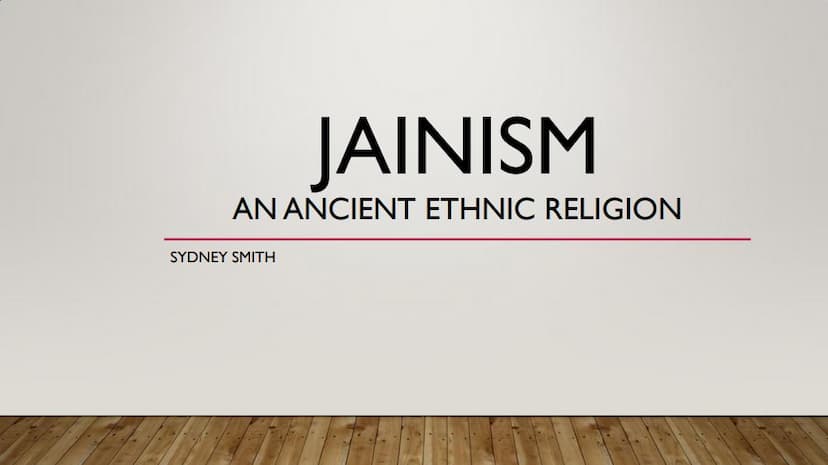Jainism An Ancient Ethnic Religion
Added to library: September 2, 2025
Loading image...

Summary
Here is a comprehensive summary of the Jain text "Jainism An Ancient Ethnic Religion" by Sydney Smith, based on the provided pages:
This document provides an overview of Jainism, describing it as an ancient ethnic religion with core beliefs, holy texts, leaders, symbols, customs, traditions, and worship practices.
Main Topics Covered:
The document outlines its coverage across the following main topics: Description, Beginnings, Diffusion of Jainism, Globalization, Analysis, and Final Conclusions.
Major Beliefs:
- The highest possible value in Jainism is non-violence (Ahimsa), encapsulated by the phrase "Ahimsa paramo dharma" (Non-violence is the supreme path).
- This non-violence must be practiced mentally, physically, and verbally, meaning one must avoid harming others in all these ways.
- The ultimate goal is Moksha, a state of complete detachment from the world. Without achieving Moksha, individuals remain trapped in the cycle of life and death, known as Samsara.
Holy Text:
- The primary holy text is called the Agama.
- It contains the teachings of the Jina Mahavira and is divided into three main branches:
- Purva: Focuses on Jaina philosophy.
- Anga: Deals with conduct and karma.
- Angabahya: Includes commentaries on the Purva and Anga topics.
- Jainism also comprises numerous other texts compiled by its followers.
Major Leaders and Figures:
- Jain society is structured around Monks/Nuns, Householders, and Followers (Jains).
- These groups are considered equal but have distinct roles. Householders support monks and nuns, who in turn share their knowledge of Jainism with the community.
- Jinas and Tirthankaras are revered figures, meaning "Conquerors" who have achieved complete detachment from worldly concerns.
- There have been 24 Tirthankaras in the current time cycle, with Mahavira being the final one. The text notes a cyclical view of time, with future cycles of degeneracy and the appearance of new Jinas.
Symbols and Iconography:
- Key symbols include:
- An outline of the universe (Lok).
- A raised hand with "ahimsa" inscribed, signifying a call to stop and think before acting.
- Four arms representing different realms of existence: heavenly beings, human beings, animal beings, and hellish beings.
- Three dots representing Right Faith, Right Knowledge, and Right Conduct.
- A curved arc and a dot symbolizing Moksha.
Customs:
- Jains are typically vegetarian or vegan to avoid harming living creatures.
- Monks and nuns may not prepare their own food, as this could be seen as harming living beings.
- Fasting is a common practice for self-discipline.
Traditions:
- Pilgrimage is a significant tradition, allowing Jains to temporarily adopt the lifestyle of monks and nuns and visit sacred sites associated with the Jinas.
- There are two main monastic traditions:
- Digambara (Male): Monks do not wear clothing, viewing it as an attachment to the world.
- Shvetambara: Monks and nuns wear white clothes and cover their mouths to avoid inadvertently harming insects.
Ceremonies:
- Fasts are observed for contemplation and penance.
- The ritual of Sallekhana involves fasting until death when one's body hinders spiritual progress.
- Devotional Worship includes reading holy texts and meditation to achieve a peaceful state of mind.
Worship Centers and Services:
- Examples of worship centers are provided through links to the Palitana Jain Temple and jsocf.org.
- Jain worship is primarily individual, unlike the Western concept of sermons or communal services. Practices include scripture study and meditation. Monks or nuns may offer guidance if present.
Beginnings:
- Jainism is native to India.
- Mahavira is considered the founder of present-day Jainism.
- While historians believe it originated 2,500 years ago, its exact beginning is uncertain because it's considered an eternal religion.
Diffusion:
- Jainism spread from northern India to southwestern India after a famine in the 4th century BCE.
- This migration led to the split into two major sects due to differing views between those who stayed and those who relocated.
Globalization:
- Jainism is not a universalizing religion as it lacks an evangelical aspect.
- It is expected to remain primarily in India, though temples exist in the US, with a significant Jain population and numerous temples in North America. The document notes that anyone who follows non-violence can be considered a fellow Jain.
Analysis:
- Jainism is characterized as an ethnic religion due to its non-evangelical nature.
- It shares similarities with Hinduism and Buddhism, predating them.
- Jainism's strong emphasis on non-violence aligns with the cultural values of India, contributing to its prevalence there.
- The religion has the potential to spread through academic study in colleges, though it is predicted to remain largely ethnic.
Conclusions:
- The author highlights that Jainism shares aspects with many religions and particularly accentuates the importance of avoiding harm.
- A key learning point is that Jainism predates Hinduism and Buddhism and is not a branch of them, dispelling a common misconception.
- The main takeaway emphasizes the value of learning about diverse world religions to broaden cultural understanding and appreciate different perspectives.